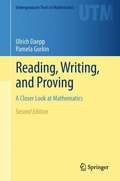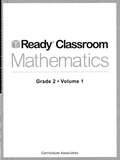- Table View
- List View
Reading Statistics and Research
by Schuyler HuckEmploying a non-intimidating writing style that emphasizes concepts rather than formulas, this uniquely welcoming text shows consumers of research how to read, understand, and critically evaluate the statistical information and research results contained in technical research reports. <p><p>Some key topics covered in this thoroughly revised text include: descriptive statistics, correlation, reliability and validity, estimation, h hypothesis testing, t-tests, ANOVA, ANCOVA, regression, multivariate analysis, factor analysis, and structural equation modeling (SEM). A number of mini-topics related to research and statistics are also discussed, such as the geometric mean, Tau-b correlation, Guttman split-half reliability, sensitivity, specificity, and the Sobel test. Additionally, the sixth edition also includes over 488 new excerpts (tables, figures, passages of text) taken from current research reports. <p><p>Written specifically for students in non-thesis Master’s Programs but also perfectly suitable for students in upper-level undergraduate statistics courses, doctoral students who must conduct dissertation research, and independent researchers who want a better handle on how to decipher and critique statistically-based research reports.
Reading and Understanding Multivariate Statistics
by Laurence G. Grimm Paul R. YarnoldThis text aims to help researchers and students to understand the purpose and presentation of multivariate statistical techniques. The most commonly used techniques are described in detail, such as multiple regression and correlation and path analysis
Reading and Writing the World with Mathematics: Toward a Pedagogy for Social Justice (Critical Social Thought)
by Eric GutsteinMathematics education in the United States can reproduce social inequalities whether schools use either "basic-skills" curricula to prepare mainly low-income students of color for low-skilled service jobs or "standards-based" curricula to ready students for knowledge-intensive positions. And working for fundamental social change and rectifying injustice are rarely included in any mathematics curriculum. <P><P>Reading and Writing the World with Mathematics argues that mathematics education should prepare students to investigate and critique injustice, and to challenge, in words and actions, oppressive structures and acts. Based on teacher-research, the book provides a theoretical framework and practical examples for how mathematics educators can connect schooling to a larger sociopolitical context and concretely teach mathematics for social justice.
Reading the Mind of God: Johannes Kepler and the Reform of Astronomy (Springer Praxis Books)
by J. V. Field T. J. Mahoney A. E. L. DavisThis volume provides a wide-ranging introduction to Kepler’s work, with essays on his religion, his cosmological theories, his work in astronomy, astrology, optics and mathematics and his interactions with Tycho Brahe and Galileo Galilei.Kepler is a major figure in the history of science. His laws of planetary motion overthrew a tradition, going back as far as the ancient Greeks, of constructing the paths of planets by combinations of circles; and the derivation of the laws was revolutionary in the way it relied upon detailed agreement with observations. Moreover, the laws explicitly relate the motion and path of each planet to the Sun. Thus, when the tables that Kepler based upon the laws proved to be highly reliable over many decades, this played a crucial part in making heliocentrism acceptable. And many years after Kepler’s death the laws themselves played an important part in Newton’s derivation of the inverse square law of gravitation in his Principia (1687). In this respect, Kepler can look ‘modern’. But his work is grounded in his religious belief that the Universe is the visible expression of the nature of the God who created it.This book, whose chapters are written by leading scholars, is primarily addressed to undergraduate and graduate students of science and the history of science but will also appeal to the general reader with an interest in the history of science.
Reading, Writing, and Proving: A Closer Look at Mathematics (2nd Edition) (Undergraduate Texts in Mathematics)
by Ulrich Daepp Pamela Gorkin<p>This book, which is based on Pólya's method of problem solving, aids students in their transition from calculus (or precalculus) to higher-level mathematics. The book begins by providing a great deal of guidance on how to approach definitions, examples, and theorems in mathematics and ends with suggested projects for independent study. <p>Students will follow Pólya's four step approach: analyzing the problem, devising a plan to solve the problem, carrying out that plan, and then determining the implication of the result. In addition to the Pólya approach to proofs, this book places special emphasis on reading proofs carefully and writing them well. The authors have included a wide variety of problems, examples, illustrations and exercises, some with hints and solutions, designed specifically to improve the student's ability to read and write proofs. <p>Historical connections are made throughout the text, and students are encouraged to use the rather extensive bibliography to begin making connections of their own. While standard texts in this area prepare students for future courses in algebra, this book also includes chapters on sequences, convergence, and metric spaces for those wanting to bridge the gap between the standard course in calculus and one in analysis.</p>
Readings in Decision Analysis
by S. FrenchProvides an introduction to decision analysis. This book is based upon a number of papers and articles taken from the Operational Research Society's journal and other publications. However, the book is not simply a 'collection of reprints': Professor French has provided extensive notes and commentary to weave the extracts into a coherent whole. Although techniques are presented, the main thrust is to convey the purpose of decision analysis and the interpretation that should be placed upon its output: vital topics, but ones seldom discussed in introductory texts. The writing is aimed at the non-technical reader.
Ready Classroom Matematicas Grado 4 Volumen 2
by Curriculum AssociatesReady® Classroom Mathematics Grade 4 - Volume 2 covers Unit-4 and Unit-5. Unit-4 Fractions, Decimals, and Measurement Addition, Subtraction, and Multiplication contains Lesson-17 to Lesson-29. Unit-5 Geometry and Measurement Figures, Classification, and Symmetry contain Lesson 30 to Lesson 34. This book also has a Bilingual Glossary.
Ready Classroom Mathematics Grade 4 - Volume 2
by Curriculum AssociatesReady® Classroom Mathematics Grade 4 - Volume 2 covers Unit-4 and Unit-5. Unit-4 Fractions, Decimals, and Measurement Addition, Subtraction, and Multiplication contains Lesson-17 to Lesson-29. Unit-5 Geometry and Measurement Figures, Classification, and Symmetry contain Lesson-30 to Lesson-34. This book also has a Bilingual Glossary.
Ready Classroom Mathematics Grade 5 Volume 1
by Curriculum AssociatesReady Classroom Mathematics Grade 5 | Volume 1
Ready Classroom Mathematics Grade 5 Volume 2
by Curriculum AssociatesReady Classroom Mathematics Grade 5 | Volume 2
Ready Classroom Mathematics: Grade 2
by Curriculum AssociatesReady Classroom Mathematics Grade 2 | Volume 1
Ready Classroom Mathematics: Volume 2
by Curriculum AssociatesTable of Contents <p><p> UNIT 4 Fractions Equivalence and Comparison, Measurement, and Data <p><p> UNIT 5 Measurement Time, Liquid Volume, and Mass <p><p> UNIT 6 Shapes Attributes and Categories, Perimeter and Area, and Partitioning <p><p>Grade 3
Ready Classroom, Mathematics, Grade 7, Volume 2
by Curriculum Associates Llc.NIMAC-sourced textbook









